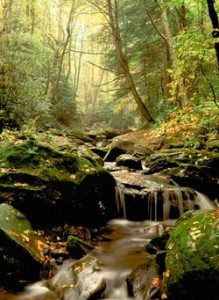Climate
Hendersonville is a little southeast of the center of Henderson County, a southern mountain county adjoining the South Carolina border. Lying between the Blue Ridge Mountains, which reach more than 3,000 feet above mean sea level in adjoining counties on the east, and the Great Smoky Mountains, rising 5,000 to 6,000 feet on the west, Hendersonville and a large proportion of Henderson County lie close to the 2,200 foot level. Hendersonville enjoys the advantages of a mountain climate, while at the same time being protected by the higher ranges from some of the rigors of winter. The barrier formed by the Great Smoky Mountains tends to hold back the flow of cold air from winter outbreaks moving southward over the plains states from central Canada; the weaker of these outbreaks are turned aside and prevented from reaching the Hendersonville area, while the stronger are tempered and modified in passing over the higher mountains. While the temperature drops below freezing on more than half the nights in winter, it usually rises above freezing by afternoon. Zero weather is extremely rare.
The average length of freeze-free growing season at Hendersonville and over the broad agricultural valley and gentle slopes, comprising most of Henderson County, is about six months of the year. The average date of last occurrence in spring of a temperature as low as 32 F at Hendersonville is April 22; of 28 F, around April 6; of 20 F, March 3. The average date of first occurrence in the autumn of 32 F is October 19; of 28 F, October 29; of 20 F, November 24.
Summer weather is pleasant in Hendersonville; it is cooler by eight to ten degrees, both day and night, than most coastal plain and piedmont locations. Ninety degree weather occurs less than one-third as often as in the eastern part of the state.
Rainfall is plentiful in the greater Hendersonville area, and very well distributed throughout the year. The heaviest amounts fall, on average, during the summer months when the heaviest demands are placed on water supplies by man, animal, agriculture and industry. The only two months having an average of less than four inches of rain are October and November, when fair weather aids the harvest of farm crops. Although located in that general area of North Carolina which has the heaviest average rainfall in the state, Hendersonville and the immediately surrounding areas are sheltered from this heavy rain by the mountain ranges on either side. The average amount of rainfall at Hendersonville is about the same as that of coastal areas of North Carolina and other southeastern states, while the distribution throughout the year is more favorable.
Some snow falls at Hendersonville almost every winter, but it is only a small fraction of that which falls on the higher peaks to the northwest, where snow can be found most of the winter. Ski slopes are active less than fifty miles from Hendersonville.
Westerly winds prevail at Hendersonville in summer, and northwesterlies at other seasons. To some extent, winds in the surrounding area are influenced by local topography. Wind speeds average eight to ten miles per hour, running somewhat higher in the early afternoon and a little lower in the early morning hours before dawn. Tropical disturbances affecting coastal North Carolina, in summer and autumn, rarely cause high winds this far inland.
The sun shines more than half the daylight hours in Hendersonville, with the most sunshine in late spring and summer. The autumn season usually provides a great deal of fine outdoor weather.
Month | Avg Temp (°F) | Avg Precip (in) | Month | Avg Temp (°F) | Avg Precip (in) |
|---|---|---|---|---|---|
January | 39 | 5.44 | July | 74.7 | 3.73 |
February | 45 | 6.00 | August | 71.7 | 1.13 |
March | 53.6 | 8.38 | September | 66.8 | 5.45 |
April | 53.4 | 6.97 | October | 55.4 | 4.61 |
May | 60.7 | 2.26 | November | 42.4 | 1.96 |
June | 67 | 5.95 | December | 47.5 | 3.33 |


